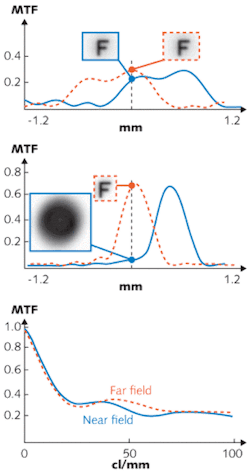A new type of contact lens created by researchers at Xceed Imaging (Petach-Tikva, Israel), Tel Aviv University (Tel Hashomer, Israel), and Bar-Ilan University (Ramat-Gan, Israel) corrects for farsightedness (hyperopia) or nearsightedness (myopia) just as ordinary contacts do, but does this with an extended depth of focus—about three diopters greater, in fact.1 The increase in focal depth has another benefit in that it corrects for astigmatism, even if the astigmatism is severe and irregular. The lens is an extension of earlier work done by the researchers on extended-depth-of-focus eyeglasses.
The added focal depth is achieved by the addition of a small number of concentric annular rings of less than 1 µm in depth on the front surface of the contact. The width and spacing of the rings are large in comparison to the optical wavelength, and thus cause virtually no diffraction. The phase shifts for the rings are determined by iteratively solving an equation whose optimal solution describes a region of extended constructive interference around the focal plane and a destructive one elsewhere. The result is that the high spatial frequencies (which are needed for image sharpness) in the constructive channel remain, but with the loss of some contrast; however, because the image is so sharp, the brain can easily compensate for the reduced contrast.
They can see clearly now
The researchers conducted a trial on 13 test subjects, whose prescriptions spanned the gamut from hyperopia (up to 3.75 diopters) to normal to myopia (up to 7.75 diopters); some had astigmatism in addition. The extended-depth-of-focus (EDOF) ring patterns were engraved into soft silicon-hydrogel contacts that were made either to the subjects’ prescriptions, if they had one, or plano, if they didn’t. The trial, which was carried out at a room luminance of 40 cd/m2, included tests for changes in visual acuity, contrast sensitivity, and amount and orientation of astigmatism.
With the EDOF lenses, subjects with prescriptions for myopia and hyperopia saw improvements of more than 1.5 diopters in distance and/or near visual acuity; in addition, those who had regular or irregular astigmatism saw an average of about 0.7 diopters of improvement. One big advantage of the EDOF pattern for astigmatism is that it is radially symmetric—unlike the toric correction in conventional contacts, which must be oriented a particular way in the eye.
The tests also showed no deterioration in color vision or stereoscopic capability with use of the EDOF lenses. Subjects who were tested with a full optical correction for near vision, and then with an optical correction for distance that included the EDOF pattern, showed no significant difference in the measurements for spatial frequencies ranging from 1.5 to 18 cycles per degree.
Unaffected by tears
But how can the EDOF surface pattern work along with the tear film created by the human eye? “We have several types of designs,” says Zeev Zalevsky of Bar-Ilan University. “There are designs matched to the refraction index of air and then there are designs matched for tears. Those matched for air have a structure in which the tears slide off it and do not enter into the engraved features.”
Zalevsky notes that along with the trial done at a luminance of 40 cd/m2, which was meant to test reading capabilities, tests were done to check for possible glare and halo effects. In this case, the subject would sit in a dark room and look at a bright light source. The EDOF lenses worked well in those tests, he says.
While the researchers need to work out several final R&D issues, Zalevsky believes that, as long as funding doesn’t run out, it will be feasible for them to produce a practical product in a year or so that can be approved for ophthalmologic use.
REFERENCE
- A. Zlotnik et al., Optics Letters 34(14) p. 2219, July 15, 2009.

